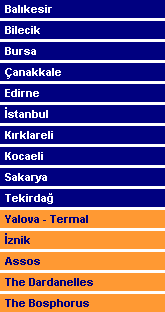| Kocaeli... |
|
Kocaeli is mostly known by its district center, Izmit. The ancient name of the city is Nikomedia. Remains from Roman and
Byzantine times may be seen here, among which are the citadel, the Temple of Augustus and the agora. The city of Izmit is
mainly an industrial center with numerous industrial establishments surrounding the Gulf of Izmit. However, there are also
many touristic sites in this bustling province. Kartepe is a winter-sports resort that reaches a height of 1600 m Kerpe
and Kefken on the Black Sea coast have fine beaches, while Golcuk and Karamursel in the Gulf of Izmit, are other beautiful
sea resorts. At Arpalik near the Eskihisar village in the Gulf of Izmit, there is a yacht berth place with a capacity of
60-80 yachts. Lake Sapanca is another natural beauty, and a scenic place ideal for picnics. One of the towns of Kocaeli is
Hereke, where the very best Turkish carpets are produced. The artistic carpets of Ottoman palaces were woven here. These
carpets are priceless and well-known all over the world. A fast highway connects Istanbul with Izmit, the capital of Kocaeli
province. An important city in Roman times when it was known as Nicomedeia, it is now a prosperous industrial center. The
Saatci Efendi Konak, a restored typical 18th-century Ottoman Mansion, now serves as the Ethnological Museum. Pismaniye, the
local sweet, consists of thousands of thin layers of stretched sugar. Hereke, west of Izmit, is a major carpet making center.
Renowned throughout the world for their beauty and quality, these carpets fetch the highest prices in Istanbul's bazaars.
On the Black Sea Coast, north of Izmit, particularly at Kerpe, Kefken and Kovanagzi, sandy beaches and comfortable guest
houses attract vacationers. A fast highway connects Istanbul with Izmit,the capital of Kocaeli province. An important city
in Roman times when it was known as Nicomedeia, it is now a prosperous industrial center. The Saatci Efendi Konak, a
restored typical 18th century Ottoman Mansion, now serves as the Ethnological Museum. Pismaniye, the local sweet,
consists of thousands of thin layers of stretched sugar. Hereke, west of Izmit, is a major carpet making center. Renowned
throughout the world for their beauty and quality, these carpets fetch the highest prices in Istanbul's bazaars. On the
Black Sea Coast, north of Izmit, particularly at Kerpe, Kefken and Kovanagzi, sandy beaches and comfortable guest houses
attract vacationers.
|
|

|


 262...
262...
 41...
41...
 1,203,335...
1,203,335...
 3,626...
3,626...
 29 E 55 - 40 N 46...
29 E 55 - 40 N 46...




